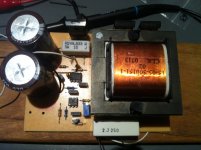Alan B
100 GW
I was wondering about using low side switching. Nice simplification. Do you have a favorite low side driver that doesn't have the 50% duty cycle limitation?

Hyena said:I'm in the "I have nothing to contribute but eagerly watch your progress" camp
A charger with an iphone-ish size footprint would be great for onboard charging, not only for e-motos like your vectrix but even many ebikes.
I'm about to start work on an madass conversion so something like this would be great for onboard plug in charging.
From your previous testing is it only at higher DC output voltages that the magic smoke starts to escape ?
If your previous/current revision is running happily at up to 150v that's a pretty respectable result in itself.
What charge voltage do you need for the vectrix ? Or are you just looking to make it as universal as possible with a wide voltage range ?
